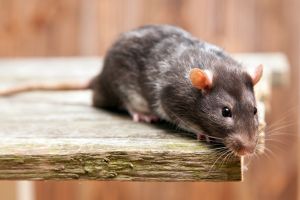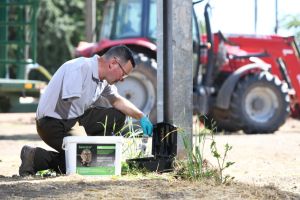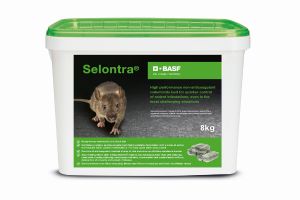The impact of rodent behaviour on a successful baiting programme
To effectively control rodents, it is important to understand rodent behaviour, especially when it comes to their neophobic behaviour. Both rats and mice are exploratory creatures, however, rats are naturally neophobic, or afraid of and avoid new things, whereas mice are naturally inquisitive in most situations but do experience neophobia in some locations like busy city centres.
Here, Laurence Barnard, Country Business Manager at BASF Pest Control Solutions, explains the different types of rodent behaviour and the best approach to overcome the challenges it presents.
What is neophobia and why does it matter?
 Neophobia is when animals, particularly rats, fear and avoid new things. It’s a way for them to stay safe from potential harm and unknown dangers. Typically, rural rats are more likely to be neophobic than city rats - this is because urbanised rodents are more comfortable with disturbances and changes around them so are less afraid. Similarly, some species of rat are more likely to experience neophobia than others, such as the black rat (Rattus rattus), which are naturally more aware of change than the brown rat (Rattus norvegicus).
Neophobia is when animals, particularly rats, fear and avoid new things. It’s a way for them to stay safe from potential harm and unknown dangers. Typically, rural rats are more likely to be neophobic than city rats - this is because urbanised rodents are more comfortable with disturbances and changes around them so are less afraid. Similarly, some species of rat are more likely to experience neophobia than others, such as the black rat (Rattus rattus), which are naturally more aware of change than the brown rat (Rattus norvegicus).
Farmers can come across neophobic behaviour from rodents due to several factors, including the placement of new bait boxes, the placement of rodenticide bait when a more consistent food source has been established, situating traps or monitoring products, and altering the environment.
Neophobic behaviour can cause an array of problems for farmers, which ultimately can lead to prolonged infestation. If rodents initially avoid the control methods, whether they be chemical or non-chemical, it can take considerable time for these rodents to get used to them and for bait uptake to occur, resulting in a longer treatment programme. Neophobia can last for several days, and sometimes several weeks if other food sources and areas of familiarity are still present, so it is important to consider this when deciding your pest management approach.
How to minimise the impact of neophobia rodent behaviour
There are several approaches which can help to reduce the impact of neophobia which farmers can implement if they fear this behaviour is occurring, such as:
-
Acclimatising the rodent bait boxes
Bait boxes can be placed at desired bait points, minus the bait, before a chemical control method (or snap-trap) is required. This allows rodents to familiarise themselves with the boxes and move freely inside and around them. Bait can be applied when needed, and ultimately should be successful due to rodents being acclimated to the bait boxes.
Once the treatment has finished, ensure the bait boxes are kept in place but remove all remaining rodenticide. This means that chemicals are not present in the environment for a longer duration than required. Alternatively, a non-toxic monitoring product, like Monitoring Paste by BASF, can be placed in the existing bait boxes and easily swapped to an active bait like Selontra®, if rodent activity is suspected, for quick and effective control.
-
Consider the bait point locations
 A site survey prior to treatment should determine the best and safest baiting points, as well as adhering to the frameworks and guidelines outlined on the label and through the CRRU code of best practice. Rats are creatures of routine and will move along trails previously used, forming noticeable runs and leaving smear marks or faecal droppings along the routes.
A site survey prior to treatment should determine the best and safest baiting points, as well as adhering to the frameworks and guidelines outlined on the label and through the CRRU code of best practice. Rats are creatures of routine and will move along trails previously used, forming noticeable runs and leaving smear marks or faecal droppings along the routes.
It’s important to place bait points along these foraging routes. Rodents may also pass several bait points to feed at their preferred location, so it cannot be assumed that one bait point will be effective and sufficient. Using multiple bait points is advantageous and recommended, especially when it comes to large infestations or issues with mice, which are sporadic feeders and, therefore could visit several bait points in one night. Ensuring sufficient bait points are present helps allow for natural rodent behaviour and maximises control.
-
Monitor the activity around the bait boxes before placing bait
To effectively monitor rodent activity, it is beneficial to place sand or tracking dust inside the bait box. This will help to identify paw prints and confirm activity. It's essential to check for evidence of activity at least once a week. Additionally, a source of food can be utilised to track when rodents feel comfortable eating inside the bait box. This feed can be either commercially bought monitoring bait, such as Monitoring Paste® by BASF, or the regular feed available to the rodents, such as swine feed at a swine farm or cut wheat at an arable farm. It's advised to check for feeding activity at least once a week.
Once rodents are consistently entering the bait boxes, it indicates they are acclimated, and neophobia has been overcome, so bait can be placed in the boxes.
-
Consider your bait choice
It is crucial that the most appealing bait is used for each location to ensure rapid acceptance from rodents. The faster rodents recognise the bait as a food source, the sooner they will begin feeding on it and quicker control can be achieved. However, rodents may still exhibit neophobic behaviour when the bait is first placed, but this will decrease with familiarity.
Bait with higher levels of quality natural food sources, like Selontra® is more palatable and therefore more likely to be readily consumed, speeding up this process. Another way to decrease the likeliness of neophobia reoccurring when bait is introduced is to use a sister active bait, that is a bait that contains the same core ingredients as the monitoring product that can help to reduce the risk of delayed treatment due to neophobic behaviour. An example is using Monitoring Paste by BASF and then switching to Selontra® when necessary.
-
Think outside the bait box
 Most chemical pest control methods call for a tamper-resistant bait box, but increasingly many farmers are reporting that both rats and mice simply won’t enter these boxes, let alone eat the bait inside due to neophobia. In this instance, and if permitted on-label, farmers can implement a covered and protected approach, or a ‘natural bait station’ method. By using materials readily available around the area, create a sturdy and secure covered area to house the bait, and hide well with layers of materials to protect non-target species from accidental exposure – for example, you might want to place the bait within a pipe, then cover that with a palette.
Most chemical pest control methods call for a tamper-resistant bait box, but increasingly many farmers are reporting that both rats and mice simply won’t enter these boxes, let alone eat the bait inside due to neophobia. In this instance, and if permitted on-label, farmers can implement a covered and protected approach, or a ‘natural bait station’ method. By using materials readily available around the area, create a sturdy and secure covered area to house the bait, and hide well with layers of materials to protect non-target species from accidental exposure – for example, you might want to place the bait within a pipe, then cover that with a palette.
If a covered and protected method is used, it is vital to ensure the bait point is clearly labelled, as per CRRU guidelines, to ensure that people on the site know the bait’s whereabouts. Remember to record exactly where your bait stations are located, both for auditing and to make checking and refilling stations easier.
-
Always follow the guidance on the label
It is important to understand and follow the guidelines present on the rodenticide product. This not only protects non-target species but also the risk to the user.
Rodent behaviour is complex, and many factors can impact the success and speed of a rodent control program. Knowledge of this behaviour is an essential tool in the toolkit. For effective and speedy rodent control, steps must be included in the baiting programme that helps minimise the impact of the rodent’s neophobic behaviour. These steps include using a bait with a high acceptance and palatability such as the BASF products Selontra®, Storm Secure® or Storm® Ultra Secure.
For more advice on baiting strategies, visit: https://www.pestcontrol.basf.co.uk/en/Services/Technical-Support-Leaflets/
To view more informative articles from BASF, click here.
- Log in to post comments

